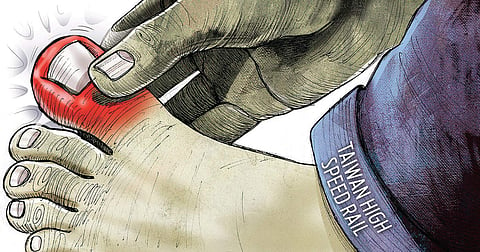

A few weeks ago I quickly descended four levels at the main railway station in Taipei, capital of Taiwan, to board a bullet train based on the Japanese Shinkansen technology. Daniel Hu, the young Taiwanese diplomat escorting a group of Asian journalists, noticed my enthusiasm; I was visibly excited because the bullet train planned to connect Mumbai with Ahmedabad from 2022 will use the same technology. Taiwan, in fact, is the first country outside Japan to have a Shinkansen bullet train—officially known as the Taiwan High Speed Rail. India will be the second. The THSR became operational in the wealthy island nation in 2007.
First things first: Our destination, Taichung, was 180 km away and we covered that distance in 50 minutes flat. The bullet train’s full 350 km long journey from Taipei to Kauhsiung—Taiwan’s second largest city and industrial powerhouse —takes as little as 90 minutes at an average speed of 233 km per hour. In comparison, the Mumbai-Ahmedabad bullet train will be sluggish: it will take three hours to cover 508 km at roughly 170 km per hour.
Countrymen, I am really sorry to dishearten you all. You can imagine my state when I realised that the bullet train that will run in India after five years will be much slower than its 2007 edition I was travelling in as a guest of Taiwan’s Ministry of Foreign Affairs. The bad news, unfortunately, is not just confined to the train’s speed.
For those of us blinded by the glitz and glamour of the planned Mumbai-Ahmedabad bullet train, Taiwan’s tryst with the Shinkansen technology can be an eye-opener—provided we are ready to see the light. Saddled with a white elephant, Taiwan took years to cut its losses. Japan’s export turned into a nightmare as all calculations went haywire and Taiwan had to make an extraordinary effort to make the best of a bad bargain.
Barely two years ago, Japan’s own Nikkei Asian Review known for its objective business coverage, called Shinkansen’s Taiwan operation a “flop”. Since the early 1990s when a Taiwanese consortium decided to import the Shinkansen technology, the project has been mired in deep financial trouble. According to Nikkei, depreciation and interest payments have been weighing heavily on the company, while poor passenger traffic has damaged the company’s balance sheet (the company expected 2,40,000 passengers a day in 2008 but in 2014 daily passenger traffic came to just over 1,30,000).
As losses kept mounting and there were no signs of a turnaround, the Taiwan government had to bail out THSR by injecting millions of dollars. The overall performance has been so disastrous that the project, executed by the private consortium under ‘build, operate and transfer’ model, will be handed over to the government in 2068 instead of 2033! The latest injection of funds has raised the government’s stake in the jinxed project to 64 per cent.
Notably, Japan’s efforts to export Shinkansen technology to other Asian nations eyeing high speed trains have been rebuffed by many governments. Taiwan’s misery and refusal by countries like Indonesia and Thailand to give in to Tokyo’s overtures, flag questions about the wisdom of the Mumbai-Ahmedabad bullet train project whose foundation was laid with fanfare by Prime Minister Narendra Modi and his Japanese counterpart Shinzo Abe.
We must study in depth THSR’s never-ending financial problems and draw lessons from the mismanagement and cost overrun although the Mumbai-Ahmedabad bullet train is not the responsibility of a private consortium’s but the Indian government’s. New Delhi’s assertion that the loan of `88,000 crores, at current exchange rates, bearing 0.1 per cent interest, with a 15-year lock-in period, repayable in 50–60 years is “in a way free” is rather dubious. The depreciation of the Rupee—which is guaranteed if we see the Re-Yen record from 1985 to the present day—will hike the principle loan amount many times over. It would be unwise to discount murmurs among the knowledgeable that the 0.1 per cent interest rate boils down to a “very lucrative investment opportunity for Japan” and is not a freebie as India claims.
Moreover, the prestigious Indian Institute of Management Ahmedabad has gone on record saying the bullet train will break even provided it carries 1,00,000 passengers daily and each one of them are ready to cough up between `4000-5000 for the ride. At present, it costs only around `2500 to fly between the two cities! I doubt very much that one lakh passengers will pay such an astronomical amount for a journey of just 508 km. Subsidies will be the only solution but at the cost of the poor. This is highly undesirable to be honest.
Since my return from Taiwan, which has a per capita income of nearly $23,000 compared to India’s roughly $1700, a spate of accidents and heinous crimes on rail have thoroughly exposed the hollowness and uselessness of India’s bullet train in the offing.A derailment in Uttar Pradesh’s Chitrakoot district killed three persons on November 24. On the same day, a train rammed into a bus at an unmanned crossing near Amethi killing four in cold blood.
These accidents, close on the heels of the bridge collapse at Elphinstone Road Station in Mumbai which left more than 20 dead show how unsafe our trains are. Equally shocking is a woman and her teenage daughter’s leap from a running train near Kanpur on November 20 to escape molesters who were not deterred by security personnel on the train. The women’s ordeal coupled with the recent train lynching of 17-year-old Junaid Khan and the savage attack on three Muslims inside a moving train near Baghpat on November 23 reveal how unsafe our trains are. Will the bullet train solve these problems?
S N M Abdi
An award-winning journalist and commentator
based in Kolkata
Email: snmabdi@yahoo.com